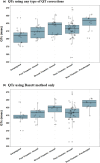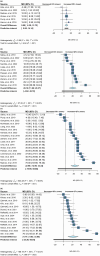QTc Interval Changes in Preeclampsia vs. Normal Pregnancy: A Systematic Review and Meta-Analysis
- PMID: 40012419
- PMCID: PMC12087697
- DOI: 10.1002/cpt.3605
QTc Interval Changes in Preeclampsia vs. Normal Pregnancy: A Systematic Review and Meta-Analysis
Abstract
Pregnancy induces significant adaptations in the cardio-autonomic nervous system, with additional cardiac stress in preeclampsia potentially impacting ventricular repolarization. Despite the widespread use of QT-prolonging drugs during pregnancy, the extent of heart rate (HR)-corrected QT (QTc) interval changes during normal pregnancy and preeclampsia remains unclear. This study aimed to quantify changes in QTc interval across different trimesters of normal pregnancy and third-trimester preeclampsia. Eight databases were systematically searched from their inception to January 13, 2025. Any type of study design, except case reports/series, reporting QT interval and HR or RR interval, and/or QTc interval for at least one trimester were included. Those reporting at least two trimesters or one trimester with nonpregnant controls were pooled in meta-analyses using random-effect models to calculate pooled mean differences (MD) across trimesters. Data from 57 studies (6,686 participants) were included with 33 studies (5,153 participants) pooled in meta-analyses. Compared with nonpregnant individuals, QTc intervals increased across trimesters of normal pregnancy and in third-trimester preeclampsia. Meta-analyses revealed significant increases in QTc interval during first (MD = 10.0 msec), second (MD = 20.2 msec), and third trimesters (MD = 23.0 msec) compared with nonpregnant individuals. Furthermore, preeclampsia increased the QTc interval by 21.7 msec during the third trimester compared to normal pregnancy. No publication bias was detected, and the overall quality scores of most studies were fair (n = 23) or poor (n = 33). A significant QTc interval lengthening throughout normal pregnancy was identified, and to a greater extent during preeclampsia. The arrhythmogenicity in third-trimester preeclampsia with a known risk for QTc interval prolongation, especially with using QT-prolonging drugs, warrants further investigation.
© 2025 The Author(s). Clinical Pharmacology & Therapeutics published by Wiley Periodicals LLC on behalf of American Society for Clinical Pharmacology and Therapeutics.
Conflict of interest statement
The authors declared no competing interests for this work.
Figures



Similar articles
-
Accuracy of placental growth factor alone or in combination with soluble fms-like tyrosine kinase-1 or maternal factors in detecting preeclampsia in asymptomatic women in the second and third trimesters: a systematic review and meta-analysis.Am J Obstet Gynecol. 2023 Sep;229(3):222-247. doi: 10.1016/j.ajog.2023.03.032. Epub 2023 Mar 28. Am J Obstet Gynecol. 2023. PMID: 36990308
-
Sertindole for schizophrenia.Cochrane Database Syst Rev. 2005 Jul 20;2005(3):CD001715. doi: 10.1002/14651858.CD001715.pub2. Cochrane Database Syst Rev. 2005. PMID: 16034864 Free PMC article.
-
Drugs for preventing postoperative nausea and vomiting in adults after general anaesthesia: a network meta-analysis.Cochrane Database Syst Rev. 2020 Oct 19;10(10):CD012859. doi: 10.1002/14651858.CD012859.pub2. Cochrane Database Syst Rev. 2020. PMID: 33075160 Free PMC article.
-
Prophylactic antibiotics for adults with chronic obstructive pulmonary disease: a network meta-analysis.Cochrane Database Syst Rev. 2021 Jan 15;1(1):CD013198. doi: 10.1002/14651858.CD013198.pub2. Cochrane Database Syst Rev. 2021. PMID: 33448349 Free PMC article.
-
Metformin for women who are overweight or obese during pregnancy for improving maternal and infant outcomes.Cochrane Database Syst Rev. 2018 Jul 24;7(7):CD010564. doi: 10.1002/14651858.CD010564.pub2. Cochrane Database Syst Rev. 2018. PMID: 30039871 Free PMC article.
References
-
- Tamirisa, K.P. et al. Arrhythmias in pregnancy. JACC Clin Electrophysiol. 8, 120–135 (2022). - PubMed
-
- Carnethon, M.R. et al. A prospective evaluation of the risk of QT prolongation with hormone replacement therapy: the atherosclerosis risk in communities study. Ann. Epidemiol. 13, 530–536 (2003). - PubMed
-
- Rodriguez, I. , Kilborn, M.J. , Liu, X.K. , Pezzullo, J.C. & Woosley, R.L. Drug‐induced QT prolongation in women during the menstrual cycle. JAMA 285, 1322–1326 (2001). - PubMed
-
- Molenaar, N.M. et al. The international prevalence of antidepressant use before, during, and after pregnancy: a systematic review and meta‐analysis of timing, type of prescriptions and geographical variability. J. Affect. Disord. 264, 82–89 (2020). - PubMed
Publication types
MeSH terms
Grants and funding
LinkOut - more resources
Full Text Sources

